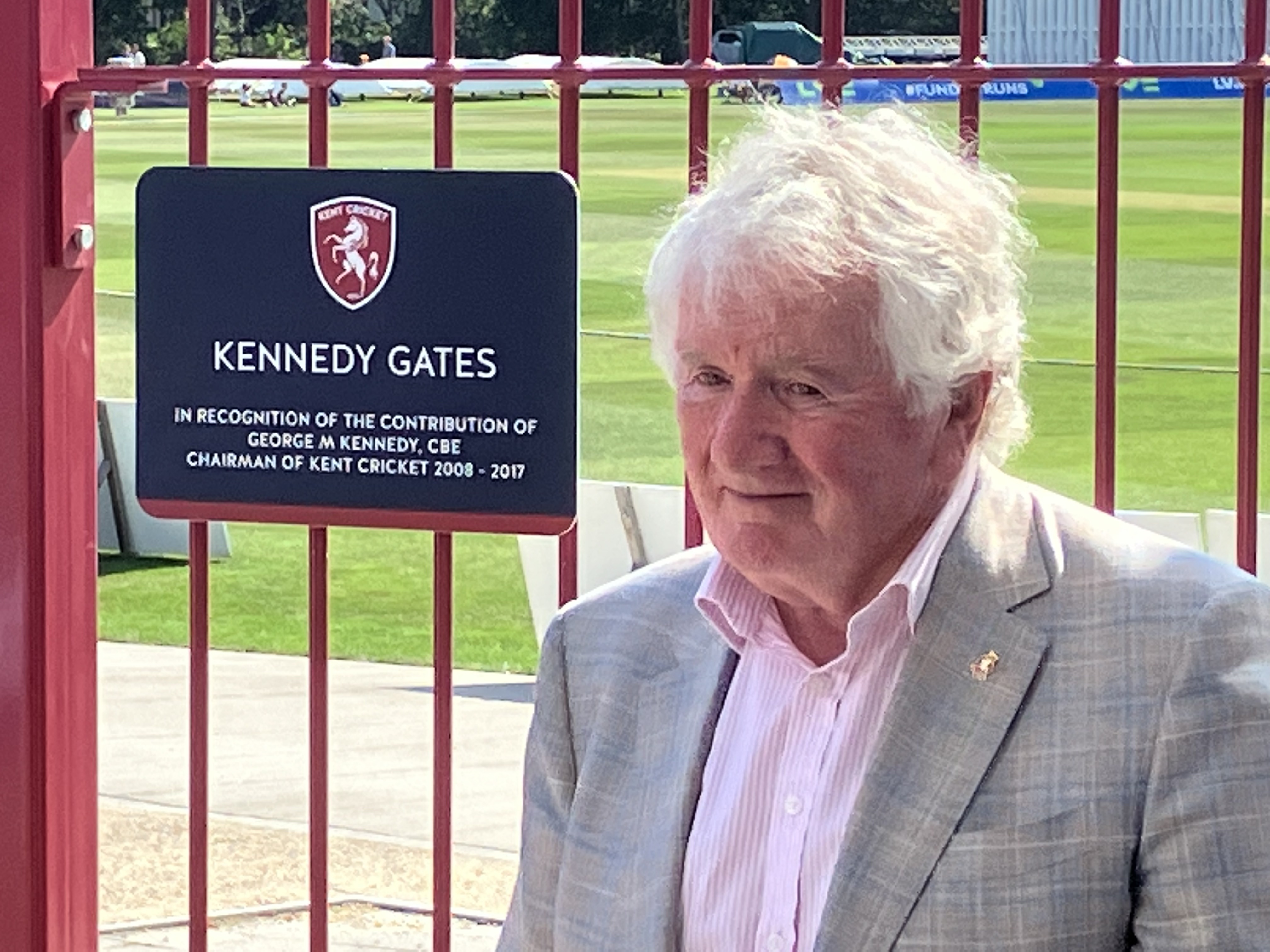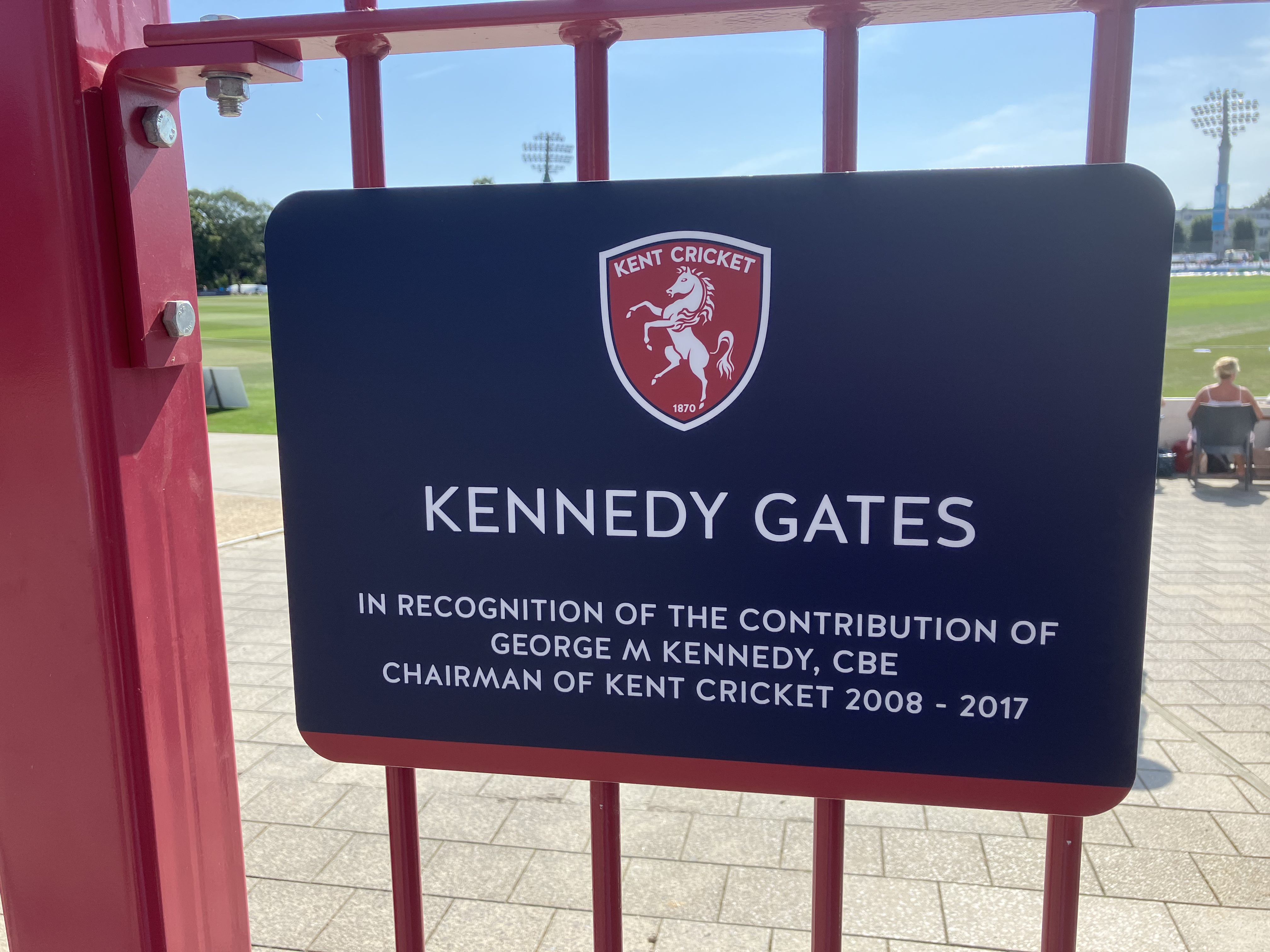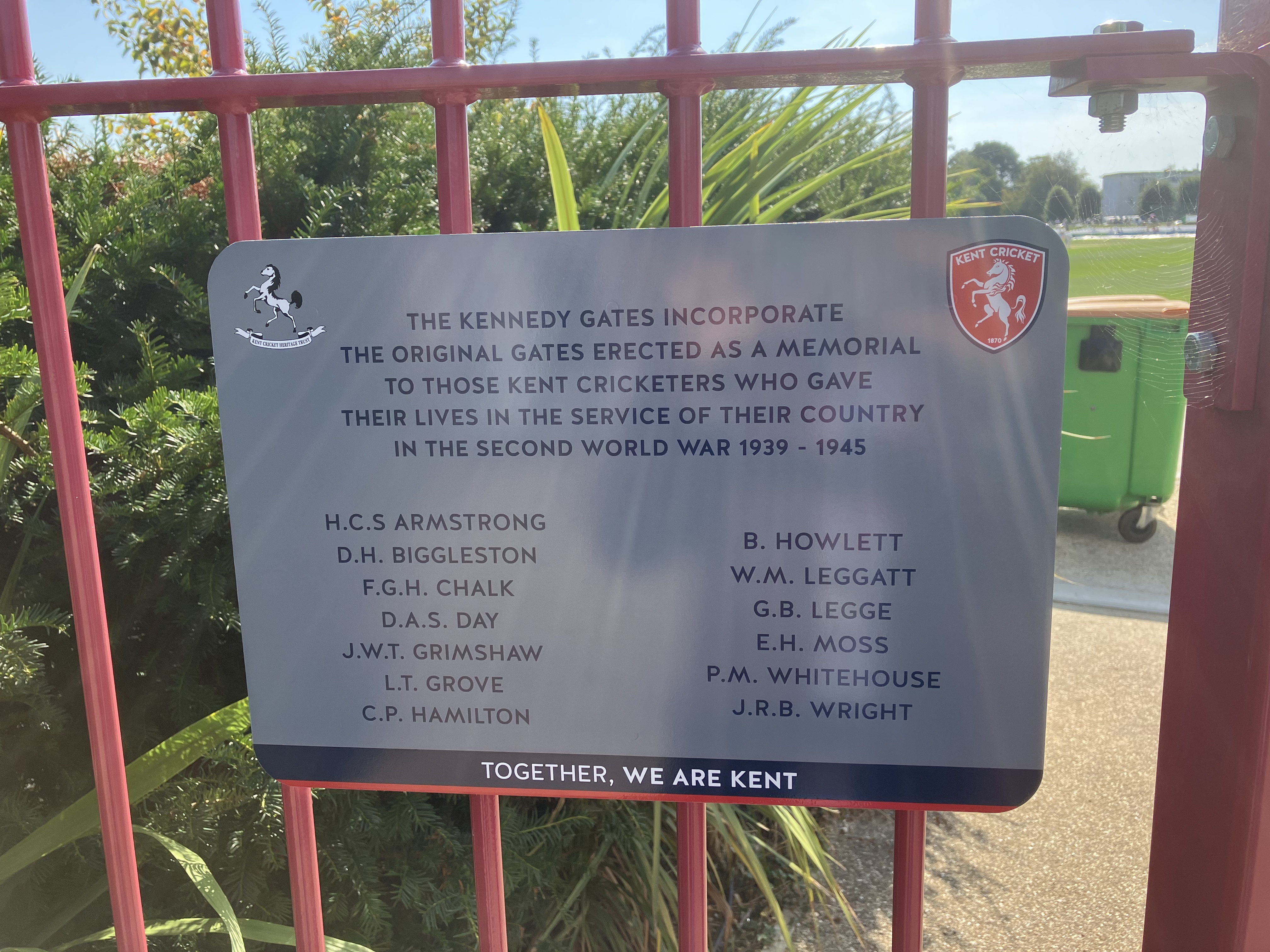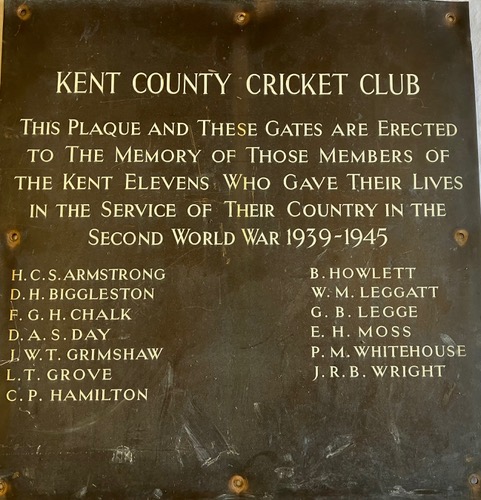
When the redevelopment of the St Lawrence Ground began over a decade ago, the turnstile gates on the Old Dover Road were among the bits that had to be demolished. They were of no great architectural merit, but when they were first built shortly after the Second World War, they were dedicated to the memory of members of Kent elevens who had died in the war.
When the new gates were being planned, it was decided to name them for George Kennedy, past chairman and president of the club, and major benefactor during the financially difficult early years of this century. It is quite likely that without George’s generosity, the club would have gone to the wall, and top class cricket in Kent with it.
However, the club also wanted to retain the memorial aspect of the gates, so the plaque which was affixed to the turnstile gates is being remembered at the Kennedy Gates, which were formally opened on Sunday 10 September by club President Chris Cowdrey and George Kennedy himself.

It honours thirteen men, who had differing levels of success as cricketers, but all of whom gave their lives for their country.
Howard Charles Sheffield Armstrong, who died on 31 January 1944 in a plane crash in Co. Donegal, Ireland, played three games for Kent Seconds in 1939 without doing anything remarkable. He was born in Tunbridge Wells in 1919 and was educated at Repton, where he played in the 1st XI.
Desmond Herbert Biggleston, who was killed on 1 July 1942 at El Alamein while serving as a lieutenant in the Royal Artillery, was born in Canterbury in 1914. He was a wicket-keeper who played 9 games for Kent Seconds between 1936, when he was 17 years old, and 1939.
Frederick Gerald Hudson Chalk, who died on 17 February 1943, when his aircraft crashed near Calais, was Kent’s captain in 1938 and 1939, one of two of our county captains to lose their life during World War Two. His death was widely mourned across the county.
David Arthur Sydney Day, who died on 22 February 1944, fighting in Arakan, Burma (now Myanmar), was the son of Arthur Day, a Kent stalwart and Wisden Cricketer of the Year in 1910. David played just 3 games for Kent Seconds in 1935. In his final appearance, against Norfolk, he was bowled by Bill Edrich for a duck.
James William Travis Grimshaw died on 26 February 1944 at Nijmegen, during Operation Market Garden. A slow left arm bowler, he played two games for Kent in 1934, taking 3 for 29 in 23 overs on debut, but his main first-class career was with Cambridge University, with whom he won his Blue in 1934 and 1935.
Col. Lancelot Townley Grove RE was a career soldier who died on 9 February 1943 in Gander, Newfoundland, where aircraft being ferried from America to Britain used to refuel before crossing the Atlantic. He played 3 games for Kent Seconds in 1937 and 1938, and a handful of first-class games for the Army and Combined Services. His top score was 106 against Cambridge University in 1938.
Major Cyril Penn Hamilton RA died on 10 February 1941 in Eritrea. He was born in Adelaide, and played 2 games for Kent in 1935. He scored 1 run in each game.
Bernard Howlett, known as “Swifty”, died on 29 November 1943 in Abruzzo, Italy. A career soldier – a brigadier with a DSO and bar when he died – he was a right-arm fast bowler who played 42 games for Kent between 1922 and 1928, taking a total of 39 wickets. He took Born in 1898 he survived the First World War, fighting in France and Flanders in 1918, but aged 44 was killed in Italy.
William Murphy Leggatt, who was born in the lovely Scottish fishing village of Crail in Fife, died on 13 August 1946 in London. He was another career soldier, who played five games for Kent in 1926 while stationed at Woolwich, hitting two 50s – 51 and 92 against Gloucestershire at Bristol. During the war he won the DSO and retired as a Lieutenant Colonel. He died from a heart attack while lunching in the Cavalry Club in London, rather than in the heat of battle, so it is not known quite why he is included on this particular roll of honour.

Geoffrey Bevington Legge, Kent’s county captain from 1928 to 1930, died on 21 November 1940 in an air crash in Devon, another casualty of a training exercise rather than the real thing. A fine batsman, he played five Tests, four of which were in the winter of 1929-30, when England simultaneously sent teams to West Indies and New Zealand. In the fourth Test at Auckland, he hit 196, the highest score by a Kent batsman for England in Tests, until Rob Key scored 221 in 2004.
Edward Henry Moss, a squadron leader in the RAF, played five first class games for Oxford University in 1933 and 1934, but did not win a Blue. He also played ten games for Kent Second XI, mainly as an opening bat, from 1929, when he was just 18, to 1933. He was shot down and died 31 March 1944, at Rimbach, Germany, and is buried in the Hanover War Cemetery.
Peter Michael William Whitehouse, who was born in Minnis Bay in 1917 but spent much of his childhood in India, died on 19 November 1943 in Archi, Italy, leading a Sikh battalion against heavy German fire. He played eight games for Kent in 1937 and 1938 as a bits and pieces all-rounder, but without any remarkable success. He also played for Oxford University from 1936 to 1938, winning his Blue in his final year.
John Roger Bodley Wright, was killed in action on 13 November 1943 in Naples, Italy, just six days before Peter Whitehouse died. Wright’s career is the most obscure of all those on the memorial. He played just one match for Kent Second XI, against Sussex Second XI, in 1939. No scorecard of the game exists. Wright was born in 1919 in Bromley and was educated at Bradfield College, where he was in the 1st XI as a batter. Beyond that, little is known of his cricketing career.
It is hard to say what any of these brave men might have achieved on the cricket field if they had survived the war, but we can always be reminded, as we walk through the Kennedy Gates, that there might now be no cricket, or indeed no Canterbury, if it has not been for the sacrifices of men like those on the memorial, and thousands like them.

0 Comments